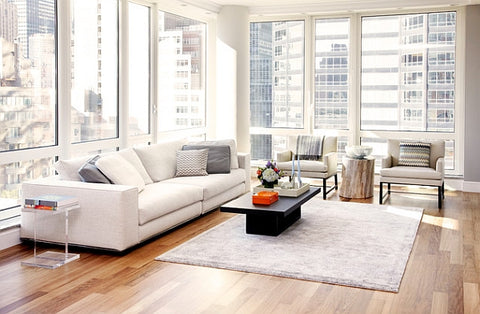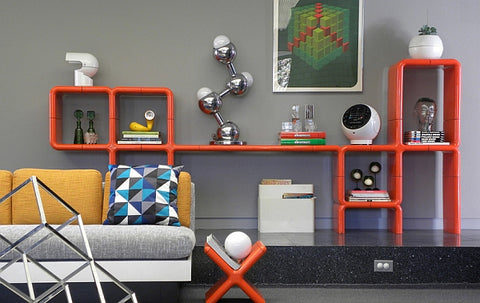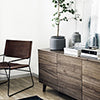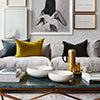Thinking about redecorating your home and looking for interior design inspiration? Understanding your own personal design style is a great starting point. Knowing which decorating style you’re drawn to will give you a foundation from which you can blend different elements together to make it your own.
In this guide, we’ll discuss the top 10 most popular interior styles and share tips about how you can achieve the look in your home. While most interior design professionals are inspired by a particular style, they tend to only use this as the foundation. Once you’ve identified the core aspects, you can start adding your own personal touches to make your interior feel like home.
1. Scandinavian

Source: Busy Boo
Closely linked with the mid-century modern interior style, Scandinavian combines minimalism with Nordic influences. The overall aesthetic is clean and functional, yet organic materials add warmth and a feeling of liveability. Scandinavian interiors are often flooded with natural light and appear uncluttered.
The colour palette is gentle and fresh featuring whites, creams, greys, tans and soft pastels. Furniture is clean lined, simple and contemporary. There’s a heavy focus on natural materials such as timber, wool, leather, linen and cotton. Modern touches such as powder coated metal frames and copper light fittings unify the style and add further texture to the interiors. Pops of colour and graphic elements are added through the use of artworks or sculpture.
To achieve the Scandinavian look there are some key elements to focus on including natural light, organic materials and furniture with clean lines. Start with a blank canvas and then layer in furniture, soft accessories and artwork, but do so with restraint.
2. Hamptons
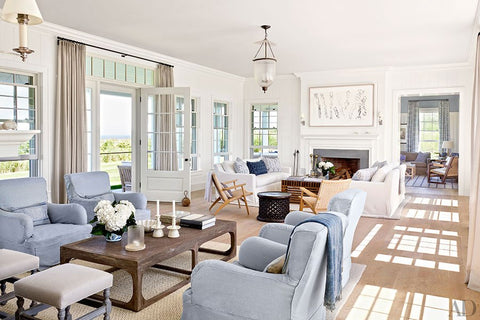
Source: Lucy Williams Interiors
The Hamptons interior design style is defined by a coastal aesthetic which originated from the beaches of U.S. Interiors of this style are light and airy, relaxed yet elegant. The spaces are usually oversized with lofty ceilings and have a seamlessly flow from indoors to outdoors.
The Hamptons style looks expensive, yet it is quite easy to achieve through a minimalist colour palette of whites, sandy creams and an accent colour of duck egg blue or navy. Furniture while clean-lined is generous and comfortable. Think deep sofas, oversized cushions and throws that are perfect to curl up in with a good book. Natural materials such as white washed floorboards and walls, sisal rugs and timber dining table are crucial to the Hamptons look.
To achieve the Hamptons design style, focus on wide and open spaces decorated in muted, classic colour tones and furniture that’s comfortable. Use natural materials as accessories and keep the overall feeling inviting and relaxed.
3. Eclectic
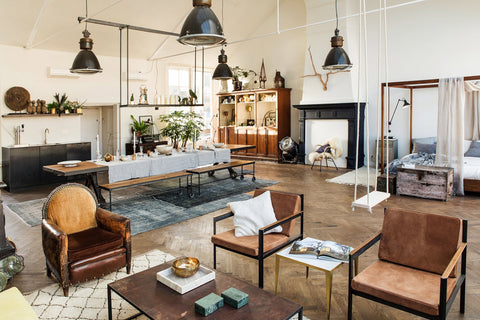
Source: enotecadellafortezza.com
If you find it hard to settle on one particular interior style, eclectic may be the one for you. The core aspect of the eclectic style is bringing together furniture and decorating elements from a variety of periods and styles.
While it may seem easy to achieve, there is a fine line between creating an eclectic interior and creating a mess. It’s all about cohesion which can be achieved through scale, composition, colour and texture. Eclectic interiors tend to start with a neutral background and then new and old pieces are mixed together. There’s often an unexpected use of texture, materials or accessory pieces and a celebration of contrasts.
To achieve the eclectic look, gather together new and old pieces of different eras. Find a common thread such as colour, shape, pattern or texture. Be playful and look for a few items that are a bit different to add personality and interest to the space.
4. Minimalist
Source: Decorist
The minimalist style is all about less is more. This modern design aesthetics keeps interior spaces clean, sophisticated and functional. There is a strong focus on quality in regard to the finishes and furniture, and a sense of functionality.
The colour palettes of minimalist interiors are typically neutral. All white interiors are popular as well as the monochromatic look featuring whites, greys and blacks. If there is colour, it’s usually introduced as an accent only. Furniture is ultra-clean lined and of a subdued colour palette. Patterns are rarely seen in a minimalist interior and instead, upholstery is usually of a solid colour tone. Finishes are modern and shiny; reflective surfaces are encouraged.
To achieve a minimalist aesthetic, it’s important to strip the space back to its barebones. Not only should the interior feel minimal, the design of furniture and fittings should also be clean-lined and functional. If you want your minimal interior to still feel inviting, opt for a warm neutral colour palette rather than the cool whites and greys.
5. Industrial
Source: syonpress.com
Harking back to the industrial era, this interior design style embodies a raw, exposed aesthetic that’s both edgy and rustic. Typical of industrial style is exposed materials like brick walls, concrete, distressed timbers and steel beams.
Converted lofts, warehouses and studios are perfectly suited to the industrial style. However, it’s a style that’s versatile and can be achieved in virtually any interior. Industrial can take on a variety of personas from rustic with modern, clean lines to rustic with a vintage touch. The interior palette can be light and sophisticated or dark and moody.
To achieve the industrial style, stick with a subdued colour palette of blacks, greys, whites and browns. Furniture that highlights materials such as metals and timbers should feature in an industrial space. Opt for vintage light fittings and accessories to complement the space. Choose graphic artwork like numbers, architectural plans or blueprints.
6. Retro
Source: Decorist
Retro interior design style mixes together old styles with modern forms, or modern styles and old forms. It combines classic and timeless pieces in an eclectic mix that’s full of personality.
A retro interior will feature bold patterns and colours you’d associate with the 50’s, 60’s and 70’s. True retro spaces are colourful, however modern retro inspired interiors tend to be more restrained with minimal pops of colour in artwork and soft furnishings. Furniture and joinery are typically seen with curved edges and in circular forms adding a sense of fluidity to the space. Texture will be added in the soft furnishing which helps add depth and interest.
To achieve the retro style, focus on adding bold colours and prints to the interior through upholstery, wallpaper or paint. Limit the colour palette to ensure it’s still coherent without being too psychedelic. Combine a touch of minimalism with retro through clean pieces of furniture that can bring relief to the space while still making a statement.
7. Tribal

Source: My Craft Work via Pinterest
The tribal interior design style places a great emphasis on craftsmanship, global influences and ethnicity. Natural materials are celebrated and layering of textures and complementary tones are essential. Tribal is an eclectic style that fuses well with other decorating styles such as minimalism and Scandi.
Tribal interiors are based around a muted colour palette typically of whites, greys, browns and blacks. There’s often accent colours of reds, oranges and blues in the accessories to add warmth, although this is done with restraint. Layering of key decorative pieces of art, Aztec rugs, fur throws, beaded cushions and lighting are what evokes the contemporary tribal feeling.
To achieve a contemporary tribal aesthetic stick to natural materials in your finishes, furniture and accessories. Building upon your look gradually, collecting pieces over time will help achieve authenticity and avoid a matchy-matchy look. Consider searching a variety of vintage stores, markets, furniture stores for tribal pieces, and of course look out for items on your travels.
8. Traditional
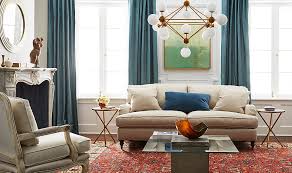
Source: One Kings Lane
A traditional interior is all about balance, sophistication and symmetry. It’s a classic, timeless and comfortable aesthetic where interiors feel calm and orderly. Pieces match, nothing feels out of place and the colour palette is understated.
The traditional design style can work well within any interior and appeals to any age group. These interiors are often featured in interior magazines as visually everything works together and the symmetry makes a space easier to photograph. There is an emphasis on quality from the furniture and fabrics to the finishes and accessories. Yet, traditional interiors don’t tend to display opulence.
To achieve the style, start with a layout that’s symmetrical and consider furniture pairings such as two identical occasional chairs next to a sofa. Look for pieces with classic lines of a mix of straight and curved. Opt for mid-range colour tones and add interest through floral, plaids, stripes or geometric patterns but do so with restraint.
9. Transitional
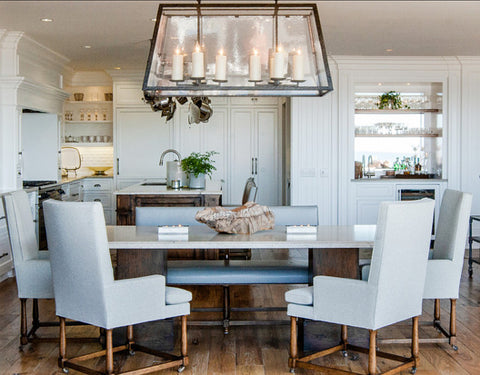
Source: Home Bunch
Transitional style is the perfect mix of modern and traditional. It’s characterised by simple, clean lines, a neutral, warm colour palette and classic pieces. It’s refined, inviting with a touch of personality. You can consider it a new, fresh take on an old classic.
Like the traditional style, transitional mixes straight lines with curves in the furnishing, joinery and architectural features such as trims and mouldings. A neutral colour scheme allows the furnishings to take centre stage and texture is added through materials including timber, metal, glass, rattan and fabric. The transitional style calls for modern and traditional furnishings to sit harmoniously with each other, such as a modern dining table with upholstered, classic chairs.
To achieve the transitional style, opt for a warm neutral palette as your base. Use a mix of classic furnishings with more contemporary pieces. Limit the number of accessories, art and fabrics in the interior to maintain a refined aesthetic. Think contemporary, yet sophisticated.
10. French Provincial
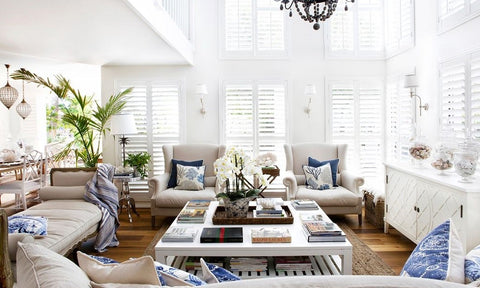
Source: House of Home
The French Provincial aesthetic is characterised by distressed timbers, a light colour palette and a rustic, yet elegant, way of life. It’s relaxed and on the verge of ‘shabby chic’ just a little more polished. Linens, shapely lines and rich patinas are all key elements of the French Provincial style.
A French Provincial interior is soothing, feminine and focuses heavily on decorative luxury. Soft colours of whites, taupes, grey and sage run throughout the interior and furnishings. Classic fittings enrich the space and vintage accessories can add the old-world charm. Materials such as natural stone, marble, rich timbers and wrought iron add to the refined aesthetic.
To achieve a French Provincial look, go with furniture that has curves and classic feel. Combine durable upholstery with more luxurious fabrics like velvets and linens. Showcase the architectures ornate decorative features or add your own touches in elaborate light fittings, mirrors and accessories.
When choosing an interior design style, use it as a launching off point. Take your time, gradually building on your interior to avoid the catalogue look. Don’t be afraid to sway from the rules and add your own personal touches. The most successful interiors are those that are reflective of the occupants and make you feel like home when you walk through the front door.
You might also like
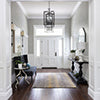 Give your entrance the wow factor with these tips
Give your entrance the wow factor with these tips
Keep your home organised with our decluttering tips
How to get creative with cushions without going over the top

